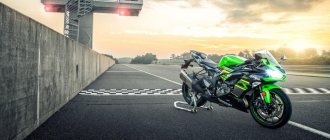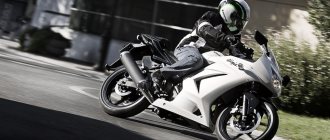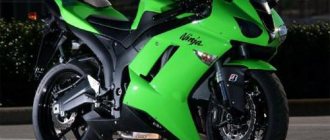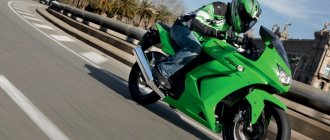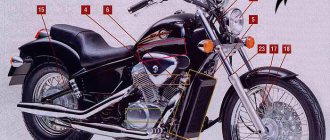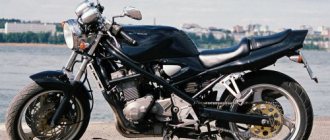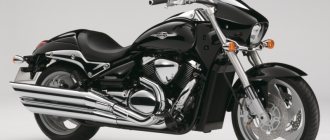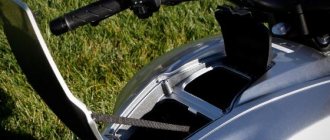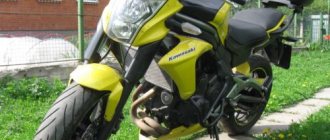| Kawasaki ER-4N (2010-2013) | Kawasaki Ninja 400R (2010-2013) | Kawasaki Ninja 400 (2014-2017) |
Kawasaki ER-4N naked model
was first introduced in August 2010 along with the
Kawasaki Ninja 400R
. In essence, both models were 400 cc domestic versions of the Kawasaki ER-6N and ER-6F. The main differences from older models were the engine, as well as the intake and exhaust systems. In all other respects they were almost identical.
The Kawasaki ER-4N and Kawasaki Ninja 400R models are produced in Thailand for the domestic Japanese market, but some models were also sold in Canada and New Zealand.
Main modifications
:
- Kawasaki ER-4N
- naked version. - Kawasaki Ninja 400R
is a version with a full plastic body kit in a sporty style.
The models were based on a 2-cylinder in-line liquid-cooled injection engine with a volume of 399 cc. see, producing 44 hp. power and 37 Nm of torque. The main characteristics of the motor are achieved at 7500-9500 rpm.
By 2014, the Kawasaki ER-4N model was discontinued, leaving only the “sports” version of the Kawasaki Ninja 400R on the market, which by that time had been restyled (based on the base from the 2nd generation Kawasaki ER-6F) and removed the letter “ R" from the name - Kawasaki Ninja 400
.
Among the features of the Kawasaki ER-4 are a steel frame, an injection engine, a simple telescopic fork and a monoshock absorber (adjustable by preload), a 6-speed gearbox, powerful 2-disc (300 mm) front brakes with ABS as an option, a fuel tank for 15 l and 199 kg curb weight.
2017 was the last year of production of the series, after which it was replaced by a sports model - the Kawasaki Ninja 400 (2018+).
The main competitors of the Kawasaki ER-4 in the class
:
- Suzuki SFV400 Gladius
- Honda CB500F/Honda CBR400R
- Yamaha MT-03
Brief history of the model
- 2010 - start of production and sales of the Kawasaki ER-4 (Ninja 400R) model.
Model:
Kawasaki ER-4N / ABS (Japan), Kawasaki Ninja 400R / ABS (Japan, Canada, New Zealand).
Frame number:
ER400B-XXXXXX.
Factory designation:
ER400BBF, ER400CBF - Kawasaki ER-4N; EX400CBF, EX400DBF – Kawasaki Ninja 400R.
- 2011-2012 - no significant changes.
Model:
Kawasaki ER-4N / ABS (Japan), Kawasaki Ninja 400R / ABS (Japan, Canada, New Zealand).
Frame number:
ER400B-XXXXXX.
Factory designation:
ER400BCF, ER400CCF - Kawasaki ER-4N; EX400CCF, EX400CCFA, EX400DCF – Kawasaki Ninja 400R.
- 2013 - no significant changes.
Model:
Kawasaki ER-4N / ABS (Japan), Kawasaki Ninja 400R / ABS (Japan, Canada, New Zealand).
Frame number:
ER400B-XXXXXX.
Factory designation:
ER400BDF, ER400CDF - Kawasaki ER-4N; EX400CDF, EX400CDFA – Kawasaki Ninja 400R.
- 2014 - the Kawasaki ER-4N model is discontinued, and the Kawasaki Ninja 400R is restyled and changes its name to Kawasaki Ninja 400.
Model:
Kawasaki Ninja 400 / ABS (Japan).
Frame number:
EX400E-XXXXXX.
Factory designation:
EX400EEF / EX400EEFA
- 2015 - no significant changes.
Model:
Kawasaki Ninja 400 / ABS (Japan).
Factory designation:
EX400FFF / EX400FFFA
- 2016 - no significant changes.
Model:
Kawasaki Ninja 400 / ABS (Japan).
Factory designation:
EX400EGF, EX400FGF
- 2017 is the final production year.
Model:
Kawasaki Ninja 400 / ABS (Japan).
Factory designation:
EX400EHF, EX400FHF
For whom
This motorcycle is probably suitable for those who do not need high speed at all, but are attracted by something sporty in the exterior of the bike. If you like modern, stylish two-wheeled motorcycles, but only need to get around the city, there can hardly be a better option than this naked bike.
The main advantages of the Kawasaki EP-4 are:
- stylish appearance to match its class;
- good data, making him one of the fastest in the class;
- balance of elements and ride comfort.
The Kawasaki ER-4 is the embodiment of design genius, because there is not a single detail in the exterior of the car that one could find fault with. You can hardly find a better bike if you want to ride a beautiful and powerful motorcycle in the city.
Specifications
Technical characteristics of Kawasaki ER-4N (Ninja 400R, Ninja 400):
| Model | Kawasaki ER-4N Kawasaki Ninja 400R Kawasaki Ninja 400 |
| Motorcycle type | naked sport tourist |
| Year of issue | 2010-2017 |
| Frame | steel |
| engine's type | 2-cylinder, 4-stroke, in-line |
| Working volume | 399 cm³ |
| Bore/Stroke | 68.4 x 54.3 mm |
| Compression ratio | 11,0:1 |
| Cooling | Liquid |
| Number of valves per cylinder | DOHC, 4 valves per cylinder |
| Fuel supply system | injector, 2x Keihin 34 mm |
| Ignition type | digital |
| Maximum power | 44 hp (32 kW) at 9500 rpm |
| Maximum torque | 37 Nm (38 kgm) at 7500 rpm |
| Clutch | Multi-disc in oil bath, cable drive |
| Transmission | 6-speed |
| type of drive | chain |
| Front tire size | 120/70ZR17 |
| Rear tire size | 160/60ZR17 |
| Front brakes | 2 discs 300 mm, 2-piston calipers (ABS) |
| Rear brakes | 1 disc, 220 mm, 1-piston caliper (ABS) |
| Front suspension | 41 mm telescopic fork, travel - 120 mm (125 mm - 2014-2017) |
| Rear suspension | monoshock absorber (preload adjustment), stroke - 125 mm (130 mm - from 2014) |
| Dimensions (Length x Width x Height) | 2100 mm × 760 mm × 1100 mm - ER-4N 2100 mm × 760 mm × 1200 mm – Ninja 400R 2110 mm × 770 mm × 1180 mm – Ninja 400 |
| Seat height | 785 mm - Er-4N 790 mm - Ninja 400R 805 mm - Ninja 400 |
| Minimum ground clearance (clearance) | 140 mm – ER-4N 145 mm – Ninja 400R 130 mm – Ninja 400 |
| Gas tank capacity | 15 l |
| Maximum speed | 170 km/h |
| Acceleration 0-100 km/h (0-60 mph) | 5.5 sec. |
| Motorcycle weight (curb) | 199 kg, 203 kg (ABS) - ER-4N 203 kg, 207 kg (ABS) - Ninja 400R 209 kg, 211 kg (ABS) - Ninja 400 |
Dimensions and weight
The bike's curb weight is 199 kilograms, but if ABS is built into the model, the weight will be 203 kilograms. This is a relatively small difference. Quite weighty, but not too heavy. This is how a city bike should be.
The length of the bike reaches 2100 millimeters. This is the average setting; Both city bikes and cruisers, as well as sports motorcycles, can have this length. Its width is 760 millimeters and its height is 1100 millimeters. The height of the motorcycle at the saddle is 785 millimeters.
The tank capacity reaches 15 liters. The bike consumes only 2.66 liters of fuel per 100 kilometers of road, which means you can ride as much as 500 kilometers without refilling, which is impressive. The dimensions meet the needs of the target audience of this model and the class of motorcycles as a whole.
Lightweight road bike Kawasaki ER-4 , produced since 2010, is, in fact, a training motorcycle, and has much in common with the famous “ruff” - Kawasaki ER-6 .
Like other 400 cc motorcycles, it is intended exclusively for the Japanese domestic market, although used copies are still distributed to other countries. The same Honda CB 400SF is one of the most frequently seen motorcycles on Russian roads, despite the fact that it was also created for the domestic Japanese market. If you look at the Kawasaki ER-4 from the outside, you may not immediately be able to distinguish it from its 600cc brother. Not surprising - the motorcycle is actually a copy of the ER-6, with the exception of the engine. Otherwise, this is the same motorcycle, except perhaps a little less powerful and a little lighter due to a more compact engine. Speaking of the engine, the liquid-cooled in-line twin installed on the ER-4 produces 42 hp. and 37 nm of torque, which is noticeably inferior to the older “four hundred”, such as the aforementioned Honda CB 400, Suzuki Bandit 400 or Yamaha XJR 400.
However, since the above-mentioned models, due to the advanced age of most copies, belong to a different price category, at the moment the main competitor of the Kawasaki ER-4 seems to be the Suzuki Gladius 400, equipped with an engine from the Suzuki SV 400 model. They are quite similar in parameters to the ER-4, but differ significantly in design. However, it’s hard to find fault with Kawasaki here - the ER-4 model looks modern and stylish, a kind of city dweller, from which you can’t tell that only a 400 cc engine is inserted into its steel frame.
However, thanks to the six-speed gearbox, the Kawasaki ER-4 is quite dynamic in the speed range used when driving around the city. The motorcycle accelerates from 0 to 100 km/h in about five and a half seconds, and its top speed is about 170 km/h, and the ER-4 really picks up the first hundred quite quickly. The engine loves to rev, and peak power occurs at around 9,500 rpm. Despite belonging to the “four hundred” class, the motorcycle has normal dimensions, like its 600 cc brother in the model range. Most motorcyclists will find it quite comfortable, leaving behind only very large bikers. The bike also weighs a lot - dry weight is approaching 190 kg, but thanks to the low center of gravity you simply don’t notice it. The modest height of the saddle (78.5 cm) also allows you to confidently reach the ground with both feet.
Quite narrow, the Kawasaki ER-4 moves around the city with ease. Moderately stiff suspensions, of course, sometimes transfer road irregularities to the rider’s fifth point, but they contribute to really good handling, for which, by the way, many people love the not very powerful but flexible ER-6. The brakes are also good, and there are versions with an ABS system, which should appeal to novice motorcyclists.
There is one caveat - due to not the highest popularity in the secondary market, and also due to the fact that customs duties for a 400 cc motorcycle are not much inferior to those for a similar 600 cc motorcycle, in Russian motorcycle dealerships they ask for the amount for a Kawasaki ER-4, comparable in price to an ER-6 several years older. But if 400cc is enough for a motorcyclist, then a fresh and ABS-equipped ER-4 may be a good choice. In addition, given the wild popularity of the ER-6, from which all consumables and 95% of spare parts are suitable for the “four hundred”, there will definitely be no problems with this.
Buying a Kawasaki er-4n: a dream motorcycle
Hi all! My name is Anechka, I’m 21 years old, and I really love motorcycles. Now I ride mainly on a mini brush, and the story about it is worth starting from the very beginning - with the story of how this handsome guy fell into my tender, raking hands.
The first motorcycle, bought in the middle of last season, an ebrik, quickly served its purpose, in my understanding, got along with me, rode around, constantly saying to the cutoff “hello, I’m going to visit you,” and the question of changing the vehicle arose .
Basic requirements for a new horse:
- no more than 600 cubic meters
- landing, during which there is no need to subsequently undergo a course of therapeutic massage
- budget - 200 k
- BEAUTIFUL!
Since the end of the 2016 season, I slept, ate and sat on VKontakte with a thought that persisted in the back of my mind - WHAT WOULD I TAKE??? I don’t remember on what fateful day I saw the ruff-six hundred, but he really inspired me - especially the version after the restyle in 2012, it seems, (look, is it really fire? Such a little bug, a high tank, a short ponytail, a daring guy with character, mur ).
But the restyled ruff cost well, was rare, and I was sure that for me it would be better to divide the cubic capacity into one and a half, or even two. At the end of January, when the money had accumulated and motor toxicosis began to take an acute form, I was seriously puzzled by the choice. Together with Stas, we sat at two laptops at the same time for several evenings and wool-wool-wool the core, looked at reviews and suffered (he because I’m tired of whining, I because the choice is too serious). We considered both Hornet and f4i (I still don’t understand whether I’m glad or not that I didn’t take it - now I really like it, but I don’t know if it’s advisable to buy such a monster).
And - get to work! — in my city, we actually find a copy of the brush (only the pre-restyling one), honestly, as we wanted, divided into one and a half — the Kawasaki er-4n scabies. A minimum of time passed between “let’s just look” and “let’s take it”: because the fish swam from the auction, traveled 2k across Russia and landed in the garage, in a condition of five (no unpleasant surprises were discovered during the season). The only negative is the weight: 200 kg loaded, but I was afraid and afraid and decided that enough was enough - I could handle it.
The owner agreed on the price without much resistance, but set one condition - we are already registering the money in my name. No DCP without a date and “let me have it, and I’ll deliver it in the spring”! Therefore - wow! — we had to drive the little brush to the traffic police station (less than a kilometer from the former owner’s house), and then to the place of winter storage. I didn’t really want to spend money on delivery using adequate methods, but I would have had to if the above-mentioned Comrade Adventurer had not promised that he would deliver the fish safe and sound to his home, where it would have to wait for spring.
Let's go! On February 14, while all normal people were celebrating Valentine's Day, Anya, in love with 200 kilograms of metal and plastic, watched from her car as the brush joyfully paraded along the icy roads.
What should a person who just bought a motorcycle look like?)))
The road home, during which I either laughed hysterically or closed my eyes in fear (not yet knowing that I would soon have winter rides, which were not as scary as it seemed); control washing so that the fish waits for the season clean; the most complex manipulations to drive the motorcycle into the entrance and the elevator (the neighbors helped, and in the evening of that day they completed the ramp. It would have come in handy...) ...
... and the brush took its honorable warm place, where it stood until spring) But that’s a completely different story :/
